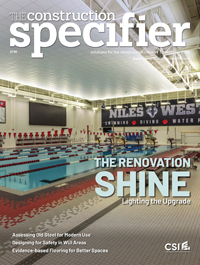Navigating the different densities of sprayfoam

Closed-cell insulation
Considered the medium-density foam class, closed-cell SPF is a rigid foam option that offers a higher R-value, or resistance to heat flow, per inch as compared to its open-cell counterparts. Instead of containing air in the cells like open-cell SPF, the cells contain a fluorine-based gas that is low in thermal conductivity, similar to double- or triple-pane windows. This gas entrapped in the cells provides the higher R-value per inch than open-cell SPF.
Closed-cell foam is ideal for continuous insulation (ci) applications in commercial structures; it can be used in both interior and exterior applications where it essentially replaces commonly utilized rigid extruded polystyrene (XPS) and polyisocyanurate (polyiso) foam boards.
Installed at a thickness of 50 mm (2 in.) or more, the material will also meet Class II vapor requirements (i.e. moisture permeance between 0.1 and 1.0 Perms) for colder climates, whereas open-cell SPF needs an additional vapor retarder coating or covering for these locations. It is also widely utilized in smaller spaces requiring higher R-values or where severe moisture could be an issue. With classification from the Federal Emergency Management Agency (FEMA) as a flood-resistant material, this type of sprayfoam insulation is widely specified in regions where flooding is more likely to occur.
Certain closed-cell sprayfoam may also be applied at temperatures as low as −15 C (5 F), making it ideal for use in colder climates where weather will not impede installation and exceptional heat flow resistance provides added benefit. These medium-density sprayfoams possess higher tensile and bond strength than low-density options and are proven to add structural strength to the building. Closed-cell foams will have a higher installed cost than open-cell SPF installed to the same R-value.
Roofing foam
In roofing applications, SPF is applied to the top surface of low-slope roofs, where it acts as both a protective material and as an insulator. Roofing foam is the highest-density and strongest class of sprayfoam with a compressive strength of 276 to 414 kPa (40 to 60 psi). This high density is essential in roofing applications, as the material must withstand normal foot traffic and provide a barrier to moisture and rain, weather cycling, and, with proper coatings, additional elements including wind, hail, and ultraviolet (UV) light.
When installed, the SPF creates a monolithic continuous insulation layer over the exterior, acting as a vapor retarder, water-resistant barrier, air barrier, and thermal insulator. Similar to low- and medium-density sprayfoam, it provides air-sealing and consistent R-value at a wide range of service temperatures.
As a roofing material, SPF is lightweight and optimal for use when:
- roof deck is an unusual configuration or shape;
- sloped application must provide the roof controlled drainage;
- substrate includes many penetrations
(e.g. photovoltaic [PV] panel supports); - structure is located in a region of extreme weather cycling;
- structure is unable to support additional weight on the roof;
- removal of the existing roofcovering is cost-prohibitive; or
- multiple roof penetrations and other roof-mounted equipment need proper flashing.
SPF roofing is considered a cost-effective option, with the installed price very competitive with other low-slope roof systems. It does require protection with a coating to prevent surface degradation from ultraviolet (UV) exposure, mechanical wear, and other weathering processes. It can be coated with a number of elastomeric coatings including acrylic, silicone, butyl rubber, polyurethane, and polyuria—however, acrylic and silicone are most commonly applied.



